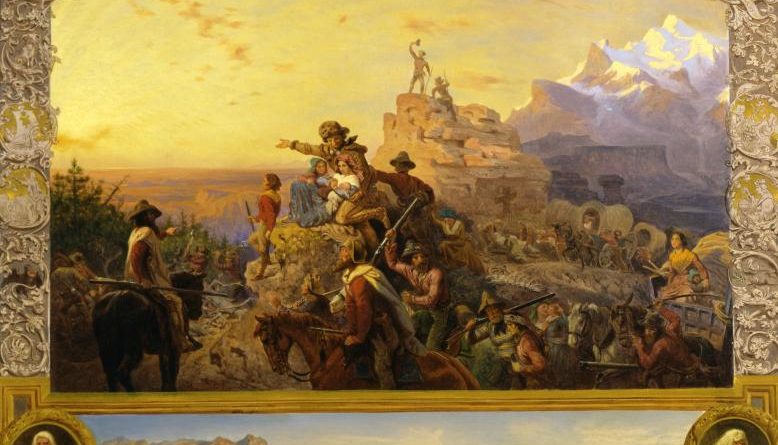Native Peoples of Americas Colloquium calls on UD, students to ‘respect the land’
The “Respecting the Land” presentation at the Native Peoples of the Americas Colloquium sheds light on Indigenous history while calling for a new perspective on land use. Photo of “Westward the Course of Empire Takes Its Way from Home” at the Smithsonian American Art Museum and Renwick Gallery Smithsonian American Art Museum.
Alex Goodlive | Contributing Writer
On Oct. 18 the University of Dayton kicked off day one of the two day Native Peoples of the Americas Colloquium, consisting of four sessions where students, professors, scholars and activists from indigenous communities come together. The annual gathering sheds light on Indigenous Peoples’ history and culture through a combination of workshops, films and presentations. The Colloquium has occurred annually since 2000 when Mary Anne Angel founded Circle of Light, which launched the Colloquium. Students were able to register to attend for PATH credit and to learn more about indigenous communities.
One of the events held on Zoom was “Respecting the Land,” which featured Tom Morgan, the director of Race and Ethnic Studies and speaker Leon Briggs, a blacksmith and activist from the Seneca Nation, Tonawanda Reserve. Briggs spoke about land use and sovereignty. He touched on the importance of protecting sacred medical plants for generations to come.
“We’re going to start tonight, I guess, with Christopher Columbus,” Briggs said early on.
Briggs explained that following the “discovery” made by Columbus, the Catholic Church played a role in the colonization of the Americas, issuing papal bulls establishing the “doctrine of discovery” where land occupied by Indigenous people who were not Christians was essentially free to take. He then discussed how Native Americans continued to lose land following the era of “Manifest Destiny” thanks to legislation such as the Dawes Act and the Indian Removal Act, forcing the Indigenous population onto reservations.
The overall theme for this year’s Colloquium was “#LandBack: Indigenous Sovereignty and Self-Determination.” Briggs noted that today there are efforts being made by Native American tribes to reclaim land that had been taken from them long ago. However, this has been a difficult task with little land having actually been gifted towards tribes. Another concern is that some of the land that has been returned is now heavily polluted, such as in the state of New York.
“We’re not getting land back in the same quality it was taken,” Briggs explained.
Because of this, he emphasized that people need to take better care of the land. This is accomplished by ensuring that there are “green spaces” and that people grow native plants rather than invasive plant species in order to restore the natural ecosystem.
Briggs is currently reaching out to several universities, including UD, calling for them to put their green spaces to better use by creating native gardens or cultural gardens to celebrate diversity on campuses. He added that the actions of one generation will impact the next seven, so people must be mindful of both those who are alive currently and the future generations to come.
Students at UD can take part as well in ways such as participating in the Dialogue Zone Session on Native Sovereignty and volunteering at the nearby SunWatch Indian village. Students can also do simple things such as paying attention to the news and partaking in cultural and festival dinners. Briggs explained that bringing diversity into your life will lead you to other people who are also looking to help out and be activists.
“Everybody’s human,” Briggs added. “We are one race.”
For more arts and entertainment news like Flyer News on Facebook and follow us on Twitter (@FlyerNews & @FlyerNewsSports) and Instagram (@flyernews)

